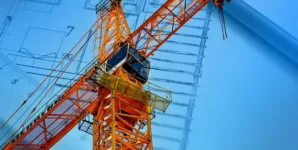Owing to the complexity of the industrial space and the tasks, a worker’s life is always in danger. Sometimes, extremely simple operations such as lifting or lowering objects can prove fatal for the industry workers as a single slipup in the mobility functionality of the equipment can wreck the operational infrastructure of a company, cost damages worth millions, and at times even claim lives. Industries where lifting heavy objects is a crucial part of everyday functioning including construction & building, transportation, and maritime logistics are continually favoring the use of cranes. And advancements in the conventional cranes has further propelled their use.
Mobile cranes- is one such type of crane that has undergone transformation and has witnessed increased adoption in recent times. As compared to conventional cranes, that are mostly stationery and has objects suspended from hooks attached to it, mobile cranes, on the other hand, are more sophisticated and has a mechanical advantage while moving heavy loads. Mobile crane has conveyor belts and wheels that are used to carry such heavy loads to places. However, owing to the possibility of improper steering of mobile cranes that may end up abruption dismounting of the heavy loads eventually causing a huge wreckage, mobile cranes still have constraints apropos to how much distance can the suspended object cover.
For mobile cranes, the ever-evolving Internet of Things (IoT) technologies are now being tested to fix its some of its shortcomings. Industrial IoT (IIoT) or commonly called industry 4.0, is expected to be transform the way mobile cranes are used by manufacturers and end-users. Incorporating enhanced IIoT technologies is anticipated to elevate the consumption of mobile cranes units in various industrial units- as compared to fixed and overhead cranes. The mobile crane market will flourish considerably instrumented by the impact of IIoT technologies. Additionally, growing industrialization will elevate the adoption of IIoT technologies- being comparatively higher in Asia-Pacific region. Employing IIoT technologies in mobile cranes has some key benefits including,
- Big Data technologies and improved analytics information will elevate the production of mobile cranes, and will also help in rectifying some existing pitfalls during manufacturing. Not just manufacturing, Big Data and predictive analysis will allow mobile cranes manufacturers to gauge which industrial verticals are presenting higher demand. According to the present market trends, the construction & building industry is projected as largest end-user of mobile cranes through 2026.
- Speedy data transferring systems along with multifunctional sensors will help users in real-time mobility monitoring of mobile cranes. Also advanced IoT technology like machine-to-machine will help users build a network of mobile cranes deployed in the company. Also, Machine Learning wil help in developing intelligent programs and enable a cognitive response functionality for mobile cranes.
- Also, when mobile cranes are deployed in companies, planners and crane operators need full information about the equipment and its working condition. Industrial IoT will help in collecting this information real-time and respond quickly and effectively to reschedule the job.
- Augmented reality worker helmets can prove to be more efficient and effective by connecting them the worker to the machine. A platform powered by IoT will help in getting updated work orders.
However, the mobile cranes market is marred by lack of standardization in terms of interoperability protocols and diverse operating architectures makes incorporating IIoT technologies a difficult task- which often gives rise to conflicting operations between multiple mobile cranes. Now, the focus has to be first on making mobile cranes ‘smarter’. The global IoT cloud will only be useful when connected to the smartest industrial machinery in the world.
The insights on the global mobile cranes market in this article have been sourced from an outlook released by Future Market Insights. Further details can be availed at https://www.futuremarketinsights.com/reports/mobile-cranes-market
Author: Abhishek Budholiya (https://twitter.com/aabudholiya02) is a tech blogger, digital marketing pro, and has contributed to numerous tech magazines. Currently, as a technology and digital branding consultant, he offers his analysis on the tech market research landscape. His forte is analyzing the commercial viability of a new breakthrough, a trait you can see in his writing. When he is not ruminating about the tech world, he can be found playing table tennis or hanging out with his friends.








